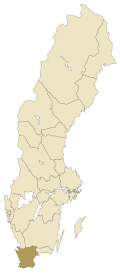Welcome to the Denmark Portal! | ||||

|

|

| |
Denmark is the smallest and southernmost of the Nordic countries. Unified in the 10th century, it is also the oldest. Located north of its only land neighbour, Germany, south-west of Sweden, and south of Norway, it is located in northern Europe. From a cultural point of view, Denmark belongs to the family of Scandinavian countries although it is not located on the Scandinavian Peninsula. The national capital is Copenhagen.
Denmark borders both the Baltic and the North Sea. The country consists of a large peninsula, Jutland, which borders Schleswig-Holstein; many islands, most notably Zealand, Funen, Vendsyssel-Thy, Lolland, and Bornholm; and hundreds of minor islands often referred to as the Danish Archipelago. Denmark has historically controlled the approach to the Baltic Sea, and those waters are also known as the Danish straits.
Denmark has been a constitutional monarchy since 1849 and is a parliamentary democracy. It became a member of the European Economic Community (now the European Union) in 1973. The Kingdom of Denmark also encompasses two off-shore territories, Greenland and the Faroe Islands, both of which enjoy wide-ranging home rule. The Danish monarchy is the oldest existing monarchy in Europe, and the national flag is the oldest state flag in continuous use.
Selected biography

Nicolas Steno (Danish: Niels Stensen) (January 10, 1638 - November 25, 1686) was a pioneer both in anatomy and geology.
After having completed his university education in Copenhagen, the city of his birth, he set out travelling in Europe; in fact, he would be on the move for the rest of his life. In the Netherlands, France, and Italy he came into contact with prominent physicians and scientists, and thanks to his eminent power of observation he very soon made important discoveries. At a time when scientific studies consisted in the study of ancient authorities, Steno was bold enough to trust his own eyes, even when his observations differed from traditional doctrines.
Steno first studied anatomy, beginning with a focus on the muscular system and the nature of muscle contraction. He used geometry to show that a contracting muscle changes its shape but not its volume.
However, in October 1666, two fishermen caught a huge shark near the town of Livorno, and Duke Ferdinand ordered its head to be sent to Steno. Steno dissected it and published his findings in 1667. Examination of the teeth of the shark showed a striking resemblance to certain stony objects, called glossopetrae or "tongue stones," that were found in certain rocks. Ancient authorities, such as the Roman author Pliny the Elder, had suggested that these stones fell from the sky or from the moon. Others were of the opinion, also going back to ancient times, that fossils naturally grew in the rocks. Steno's contemporary Athanasius Kircher, for example, attributed fossils to a "lapidifying virtue diffused through the whole body of the geocosm."
Recently selected: Knud Rasmussen - Johan Ludvig Heiberg - Carl Nielsen
Selected picture
Selected article
Scanian was previously classified as a regional language by SIL International, but before the latest update, the Swedish representative to ISO/TC-37, the technical committee overseeing ISO 639, required that Scanian be removed from the ISO/DIS 639-3, the draft just prior to the final draft FDIS, or a positive vote from Sweden would not be forthcoming. The prior identifier ISO 639-3:scy, as used in the Ethnologue 15th edition, is reserved for Scanian, and may become active again if a request is submitted to have it reinstated during the annual review process. Within the previous SIL International classification of Scanian were the dialects in the province of Scania, some of the southern dialects of Halland (halländska in Swedish), the dialects of Blekinge (blekingska in Swedish) and the dialects of the Danish island of Bornholm (bornholmsk in Danish).
Selected place
The ring castle had an inner diameter of 240 metres. The ditch was located eight meters outside the rampart, and was approximately 1.3 metres deep. The wall is believed to have been four metres tall. The rampart was constructed of soil and turf, reinforced and clad with oak wood. The rampart formed the basis for a wooden parapet. Smaller streets were located within the four main sections of the fortress.
Categories
Denmark topics
Things you can do
- Expand stubs:
Geography stubs · People stubs · Denmark stubs in general
Help us extend these stubs and make them real articles!
- Categorize:
Help us categorize Denmark-related articles
- WikiProjects:
Have a look at WikiProject Denmark, WikiProject Faroe Islands, WikiProject Greenland and WikiProject Norse history and culture
- Noticeboard:
Have a look at the Danish Wikipedians' notice board
- Geotag:
Find coordinates for these locations and tag them: articles missing geocoordinate data
Related portals
Northern Europe
Other countries
Associated WikiMedia
The following Wikimedia Foundation sister projects provide more on this subject:
-
Commons
Free media repository -
Wikibooks
Free textbooks and manuals -
Wikidata
Free knowledge base -
Wikinews
Free-content news -
Wikiquote
Collection of quotations -
Wikisource
Free-content library -
Wikispecies
Directory of species -
Wikiversity
Free learning tools -
Wikivoyage
Free travel guide -
Wiktionary
Dictionary and thesaurus













